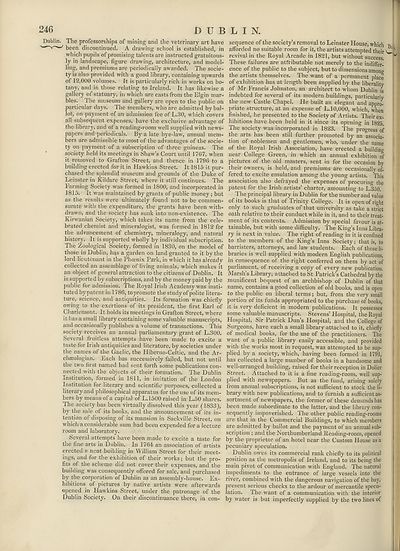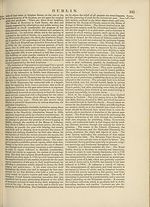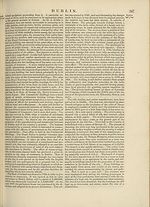Encyclopaedia Britannica > Volume 8, DIA-England
(256) Page 246
Download files
Complete book:
Individual page:
Thumbnail gallery: Grid view | List view

246
DUBLIN.
Dublin. The professorships of mining and the veterinary art have
been discontinued. A drawing school is established, in
which pupils of promising talents are instructed gratuitous¬
ly in landscape, figure drawing, architecture, and model¬
ling, and premiums are periodically awarded. The socie¬
ty is also provided with a good library, containing upwards
of 12,000 volumes. It is particularly rich in works on bo¬
tany, and in those relating to Ireland. It has likewise a
gallery of statuary, in which are casts from the Elgin mar¬
bles. The museum and gallery are open to the public on
particular days. The members, who are admitted by bal¬
lot, on payment of an admission fee of L.30, which covers
all subsequent expenses, have the exclusive advantage of
the library, and of a reading-room well supplied with news¬
papers and periodicals. By a late bye-law, annual mem¬
bers are admissible to most of the advantages of the socie¬
ty on payment of a subscription of three guineas. The
society held its meetings in Shaw’s Court until 1767, when
it removed to Grafton Street, and thence in 1796 to a
building erected for it in Hawkins Street. It 1815 it pur¬
chased the splendid museum and grounds of the Duke of
Leinster in Kildare Street, where it still continues. The
Farming Society was formed in 1800, and incorporated in
1815. It was maintained by grants of public money ; but
as the results were ultimately found not to be commen¬
surate with the expenditure, the grants have been with¬
drawn, and the society has sunk into non-existence. The
Kuwvanian Society, which takes its name from the cele¬
brated chemist and mineralogist, was formed in 1812 for
the advancement of chemistry, mineralogy, and natural
history. It is supported wholly by individual subscription.
The Zoological Society, formed in 1830, on the model of
those in Dublin, has a garden on land granted to it by the
lord lieutenant in the Phoenix Park, in which it has already
collected an assemblage of living animals, which makes it
an object of general attraction to the citizens of Dublin. It
is supported by subscriptions, and by the money paid by the
public for admission. The Royal Irish Academy was insti¬
tuted bypatent in 1786, topromote the study of polite litera¬
ture, science, and antiquities. Its formation was chiefly
owing to the exertions of its president, the first Earl of
Charlemont. It holds its meetings in Grafton Street, where
it has a small library containing some valuable manuscripts,
and occasionally publishes a volume of transactions. This
society receives an annual parliamentary grant of L.300.
Several fruitless attempts have been made to excite a
taste for Irish antiquities and literature, by societies under
the names of the Gaelic, the Hiberno-Celtic, and the Ar~
chaeologian. Each has successively failed, but not until
the two first named had sent forth some publications con¬
nected with the objects of their formation. The Dublin
Institution, formed in 1811, in imitation of the London
Institution for literary and scientific purposes, collected a
literary and philosophical apparatus for the use of its mem¬
bers by means of a capital of L.1500 raised in L.50 shares.
The society has been virtually dissolved this year (1833),
by the sale of its books, and the announcement of its in¬
tention of disposing of its mansion in Sackville Street, on
which a considerable sum had been expended for a lecture
room and laboratory.
Several attempts have been made to excite a taste for
the fine arts in Dublin. In 1764 an association of artists
erected p neat building in William Street for their meet¬
ings, and for the exhibition of their works; but the pro¬
fits of the scheme did not cover their expenses, and the
building was consequently offered for sale, and purchased
by the corporation of Dublin as an assembly-house. Ex¬
hibitions of pictures by native artists were afterwards
opened in Hawkins Street, under the patronage of the
Dublin Society. On their discontinuance there, in con¬
sequence of the society’s removal to Leinster House, which n
afforded no suitable room for it, the artists attempted their W ''
revival in the Royal Arcade in 1821, but without success. ^
These failures are attributable not merely to the indiffer-*
ence of the public to the subject, but to dissensions among
the artists themselves. The want of a permanent place
of exhibition has at length been supplied by the liberality
of Mr Francis Johnston, an architect to whom Dublin is
indebted for several of its modern buildings, particularly
the new Castle Chapel. He built an elegant and appro¬
priate structure, at an expense of L. 10,000, which, when
finished, he presented to the Society of Artists. Their ex¬
hibitions have been held in it since its opening in 1825.
The society was incorporated in 1823. The progress of
the arts has been still further promoted by an associa¬
tion of noblemen and gentlemen, who, under the name
of the Royal Irish Association, have erected a building
near College Green, in which an annual exhibition of
pictures of the old masters, sent in for the occasion by
their Owners, is held, and premiums are occasionally of¬
fered to excite emulation among the young artists. This
association also defrayed the expenses of procuring the
patent for the Irish artists’ charter, amounting to L.350.
The principal library in Dublin for the number and value
of its books is that of Trinity College. It is open of right
only to such graduates of that university as take a strict
oath relative to their conduct while in it, and to their treat¬
ment of its contents. Admission by special favour is at¬
tainable, but with some difficulty. The King’s Inns Libra¬
ry is next in value. The right of reading in it is confined
to the members of the King’s Inns Society; that is, to
barristers, attorneys, and law students. Each of these li¬
braries is well supplied with modern English publications,
in consequence of the right conferred on them by act of
parliament, of receiving a copy of every new publication.
Marsh’s Library, attached to St Patrick’s Cathedral by the
munificent bequest of an archbishop of Dublin of that
name, contains a good collection of old books, and is open
to the public on liberal terms; but, from the very small
portion of its funds appropriated to the purchase of books,
it is very deficient in modern publications. It possesses
some valuable manuscripts. Stevens’ Hospital, the Royal
Hospital, Sir Patrick Dun’s Hospital, and the College of
Surgeons, have each a small library attached to it, chiefly
of medical books, for the use of the practitioners. The
want of a public library easily accessible, and provided
with the works most in request, w'as attempted to be sup¬
plied by a society, which, having been formed in 1791,
has collected a large number of books in a handsome and
well-arranged building, raised for their reception in Dolier
Street. Attached to it is a fine reading-room, well sup¬
plied with newspapers. But as the fund, arising solely
from annual subscriptions, is not sufficient to stock the li¬
brary with new publications, and to furnish a sufficient as¬
sortment of newspapers, the former of these demands has
been made subordinate to the latter, and the library con¬
sequently impoverished. The other public reading-rooms
are that in the Commercial Buildings, to which members
are admitted by ballot and the payment of an annual sub¬
scription ; and the Northumberland Reading-room, opened
by the proprietor of an hotel near the Custom House as a
pecuniary speculation.
Dublin owes its commercial rank chiefly to its political
position as the metropolis of Ireland, and to its being the
main pivot of communication with England. The natural
impediments to the entrance of large vessels into the
river, combined with the dangerous navigation of the bay,
present serious checks to the ardour of mercantile specu¬
lation. The want of a communication with the interior
by water is but imperfectly supplied by the two lines of
DUBLIN.
Dublin. The professorships of mining and the veterinary art have
been discontinued. A drawing school is established, in
which pupils of promising talents are instructed gratuitous¬
ly in landscape, figure drawing, architecture, and model¬
ling, and premiums are periodically awarded. The socie¬
ty is also provided with a good library, containing upwards
of 12,000 volumes. It is particularly rich in works on bo¬
tany, and in those relating to Ireland. It has likewise a
gallery of statuary, in which are casts from the Elgin mar¬
bles. The museum and gallery are open to the public on
particular days. The members, who are admitted by bal¬
lot, on payment of an admission fee of L.30, which covers
all subsequent expenses, have the exclusive advantage of
the library, and of a reading-room well supplied with news¬
papers and periodicals. By a late bye-law, annual mem¬
bers are admissible to most of the advantages of the socie¬
ty on payment of a subscription of three guineas. The
society held its meetings in Shaw’s Court until 1767, when
it removed to Grafton Street, and thence in 1796 to a
building erected for it in Hawkins Street. It 1815 it pur¬
chased the splendid museum and grounds of the Duke of
Leinster in Kildare Street, where it still continues. The
Farming Society was formed in 1800, and incorporated in
1815. It was maintained by grants of public money ; but
as the results were ultimately found not to be commen¬
surate with the expenditure, the grants have been with¬
drawn, and the society has sunk into non-existence. The
Kuwvanian Society, which takes its name from the cele¬
brated chemist and mineralogist, was formed in 1812 for
the advancement of chemistry, mineralogy, and natural
history. It is supported wholly by individual subscription.
The Zoological Society, formed in 1830, on the model of
those in Dublin, has a garden on land granted to it by the
lord lieutenant in the Phoenix Park, in which it has already
collected an assemblage of living animals, which makes it
an object of general attraction to the citizens of Dublin. It
is supported by subscriptions, and by the money paid by the
public for admission. The Royal Irish Academy was insti¬
tuted bypatent in 1786, topromote the study of polite litera¬
ture, science, and antiquities. Its formation was chiefly
owing to the exertions of its president, the first Earl of
Charlemont. It holds its meetings in Grafton Street, where
it has a small library containing some valuable manuscripts,
and occasionally publishes a volume of transactions. This
society receives an annual parliamentary grant of L.300.
Several fruitless attempts have been made to excite a
taste for Irish antiquities and literature, by societies under
the names of the Gaelic, the Hiberno-Celtic, and the Ar~
chaeologian. Each has successively failed, but not until
the two first named had sent forth some publications con¬
nected with the objects of their formation. The Dublin
Institution, formed in 1811, in imitation of the London
Institution for literary and scientific purposes, collected a
literary and philosophical apparatus for the use of its mem¬
bers by means of a capital of L.1500 raised in L.50 shares.
The society has been virtually dissolved this year (1833),
by the sale of its books, and the announcement of its in¬
tention of disposing of its mansion in Sackville Street, on
which a considerable sum had been expended for a lecture
room and laboratory.
Several attempts have been made to excite a taste for
the fine arts in Dublin. In 1764 an association of artists
erected p neat building in William Street for their meet¬
ings, and for the exhibition of their works; but the pro¬
fits of the scheme did not cover their expenses, and the
building was consequently offered for sale, and purchased
by the corporation of Dublin as an assembly-house. Ex¬
hibitions of pictures by native artists were afterwards
opened in Hawkins Street, under the patronage of the
Dublin Society. On their discontinuance there, in con¬
sequence of the society’s removal to Leinster House, which n
afforded no suitable room for it, the artists attempted their W ''
revival in the Royal Arcade in 1821, but without success. ^
These failures are attributable not merely to the indiffer-*
ence of the public to the subject, but to dissensions among
the artists themselves. The want of a permanent place
of exhibition has at length been supplied by the liberality
of Mr Francis Johnston, an architect to whom Dublin is
indebted for several of its modern buildings, particularly
the new Castle Chapel. He built an elegant and appro¬
priate structure, at an expense of L. 10,000, which, when
finished, he presented to the Society of Artists. Their ex¬
hibitions have been held in it since its opening in 1825.
The society was incorporated in 1823. The progress of
the arts has been still further promoted by an associa¬
tion of noblemen and gentlemen, who, under the name
of the Royal Irish Association, have erected a building
near College Green, in which an annual exhibition of
pictures of the old masters, sent in for the occasion by
their Owners, is held, and premiums are occasionally of¬
fered to excite emulation among the young artists. This
association also defrayed the expenses of procuring the
patent for the Irish artists’ charter, amounting to L.350.
The principal library in Dublin for the number and value
of its books is that of Trinity College. It is open of right
only to such graduates of that university as take a strict
oath relative to their conduct while in it, and to their treat¬
ment of its contents. Admission by special favour is at¬
tainable, but with some difficulty. The King’s Inns Libra¬
ry is next in value. The right of reading in it is confined
to the members of the King’s Inns Society; that is, to
barristers, attorneys, and law students. Each of these li¬
braries is well supplied with modern English publications,
in consequence of the right conferred on them by act of
parliament, of receiving a copy of every new publication.
Marsh’s Library, attached to St Patrick’s Cathedral by the
munificent bequest of an archbishop of Dublin of that
name, contains a good collection of old books, and is open
to the public on liberal terms; but, from the very small
portion of its funds appropriated to the purchase of books,
it is very deficient in modern publications. It possesses
some valuable manuscripts. Stevens’ Hospital, the Royal
Hospital, Sir Patrick Dun’s Hospital, and the College of
Surgeons, have each a small library attached to it, chiefly
of medical books, for the use of the practitioners. The
want of a public library easily accessible, and provided
with the works most in request, w'as attempted to be sup¬
plied by a society, which, having been formed in 1791,
has collected a large number of books in a handsome and
well-arranged building, raised for their reception in Dolier
Street. Attached to it is a fine reading-room, well sup¬
plied with newspapers. But as the fund, arising solely
from annual subscriptions, is not sufficient to stock the li¬
brary with new publications, and to furnish a sufficient as¬
sortment of newspapers, the former of these demands has
been made subordinate to the latter, and the library con¬
sequently impoverished. The other public reading-rooms
are that in the Commercial Buildings, to which members
are admitted by ballot and the payment of an annual sub¬
scription ; and the Northumberland Reading-room, opened
by the proprietor of an hotel near the Custom House as a
pecuniary speculation.
Dublin owes its commercial rank chiefly to its political
position as the metropolis of Ireland, and to its being the
main pivot of communication with England. The natural
impediments to the entrance of large vessels into the
river, combined with the dangerous navigation of the bay,
present serious checks to the ardour of mercantile specu¬
lation. The want of a communication with the interior
by water is but imperfectly supplied by the two lines of
Set display mode to:
![]() Universal Viewer |
Universal Viewer | ![]() Mirador |
Large image | Transcription
Mirador |
Large image | Transcription
Images and transcriptions on this page, including medium image downloads, may be used under the Creative Commons Attribution 4.0 International Licence unless otherwise stated. ![]()
| Encyclopaedia Britannica > Encyclopaedia Britannica > Volume 8, DIA-England > (256) Page 246 |
|---|
| Permanent URL | https://digital.nls.uk/193326333 |
|---|
| Attribution and copyright: |
|
|---|
| Description | Ten editions of 'Encyclopaedia Britannica', issued from 1768-1903, in 231 volumes. Originally issued in 100 weekly parts (3 volumes) between 1768 and 1771 by publishers: Colin Macfarquhar and Andrew Bell (Edinburgh); editor: William Smellie: engraver: Andrew Bell. Expanded editions in the 19th century featured more volumes and contributions from leading experts in their fields. Managed and published in Edinburgh up to the 9th edition (25 volumes, from 1875-1889); the 10th edition (1902-1903) re-issued the 9th edition, with 11 supplementary volumes. |
|---|---|
| Additional NLS resources: |
|

